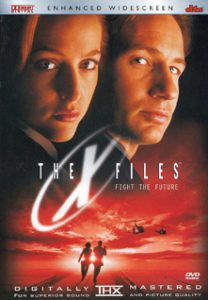I enjoyed watching “The X-Files: Fight the Future” (1998) more on this viewing than on previous viewings. I think my method of watching the episodes in order, at a fairly brisk clip, and not dwelling too much on the details of the mythology is paying off.
The biggest revelation on my “rewatching ‘The X-Files'” project has been the subtle (but clear in retrospect) love story between Mulder and Scully. The whole series can play as a romance if you choose to look at it that way, and the first movie can too. Sure, when M&S worry about being split up, they are ostensibly worried about the end of their fruitful working partnership on the X-Files. Sure, when Mulder tells Scully she makes him complete, he’s ostensibly talking about his role as an investigator. Sure, when Mulder goes to the end of the Earth to save her life, it’s ostensibly what he would do for any friend.
But I don’t think it’s a coincidence that these scenes can be read in a romantic way as well. In retrospect, it’s a cool feat that Chris Carter wrote the relationship to appeal to both romantics and those who appreciated the partners’ working relationship. (Although, granted, the near kiss in the hallway — stopped only by Scully getting stung by a bee — does paint them as more than just co-workers.)
Speaking of serving dual masters, “Fight the Future” also aimed to appeal to both fans and non-fans, as I learned from the interviews with Carter and Frank Spotnitz on the “making of” featurette included on the DVD. I always find it odd when long-running shows worry about appealing to new viewers; I think they’d be better off appealing to loyal viewers, because 1, new viewers will feel like outsiders no matter what you do, and 2, nothing was stopping new viewers from catching the show in syndication back in 1998 or from watching it on DVD or various web options today.
I guess the movie achieves its goal (although like I say, there’s no reason for this to be your entry point into the series; just start from the beginning). I’ve mentioned in previous posts that the mythology episodes are often variations on established themes rather than radical advancements of the story (hence the complaints back in the day about it being slow-moving, although it plays much better when watching the DVDs). In a way, the movie offers nothing new; it just tells the same old story with a bigger budget.
The biggest developments are:
- The black oil includes a more virulent strain than we’ve known so far: When this latest version infects someone, it grows a monster-alien in the humans’ belly a la “Alien.”
- The Syndicate has succeeded in developing a vaccine. This is how Mulder is able to save Scully. But it’s a “weak” vaccine, so it can only cure people in the early stages of infection.
- The black oil can be transmitted by bee stings. We already saw this when it was tested using polio in Season 4’s “Zero Sum,” but now we see it put into action with the black oil.
- The Well-Manicured Man is killed (presumably by one of his higher-ups) after giving Mulder a vial of the weak vaccine and the coordinates of Scully’s location.
Otherwise, like I say, it’s just Mulder and Scully being put through their paces again, only this time there are “film actors” aboard (Martin Landau is a Deep Throat-like informant, Blythe Danner is one of the FBI higher-ups who interrogates Scully and Armin Mueller-Stahl is the Syndicate’s leader) and huge set pieces (a building blows up in Dallas, M&S are chased through a corn field by helicopters and Mulder goes to Antarctica to rescue Scully from a gestation pod in a buried alien spacecraft).

I don’t mean to disparage the hard work the filmmakers did on those sets and sequences, but I think sometimes they overestimate how crucial size is to the quality of the picture. What’s memorable about “Fight the Future” is the hallway scene where Mulder tells Scully how much she means to him, and the spaceship-escape sequence where — wrapped around each others’ shoulders — they help each other to keep moving. When I see the vast interior of the alien craft or the explosion of the Dallas building or the huge bee arena, I tend to think, “Oh, they made it extra-big because they had more time and money.”
On the other hand, all that big stuff doesn’t detract from the movie by any means, and I kind of appreciate that “Fight the Future” has a blockbuster feel to it since 1998 was the height of “The X-Files” popularity and the revelations here serve as a de facto climax to the mythology arc that would mostly be wrapped up in Season 6’s “Two Fathers” / “One Son.” Basically, the story is big enough that it earns the right to be played big.
Still, as the decidedly lower-budget second movie (2008’s “I Want to Believe”) emphasized, “The X-Files” is at its heart the story of Mulder and Scully. At the end of the day — even if viewers aren’t totally clear on the black oil, the bees and the colonization plans (although they should be, if they’ve been paying attention) — the stories of the heart are what make “Fight the Future” work, too.

